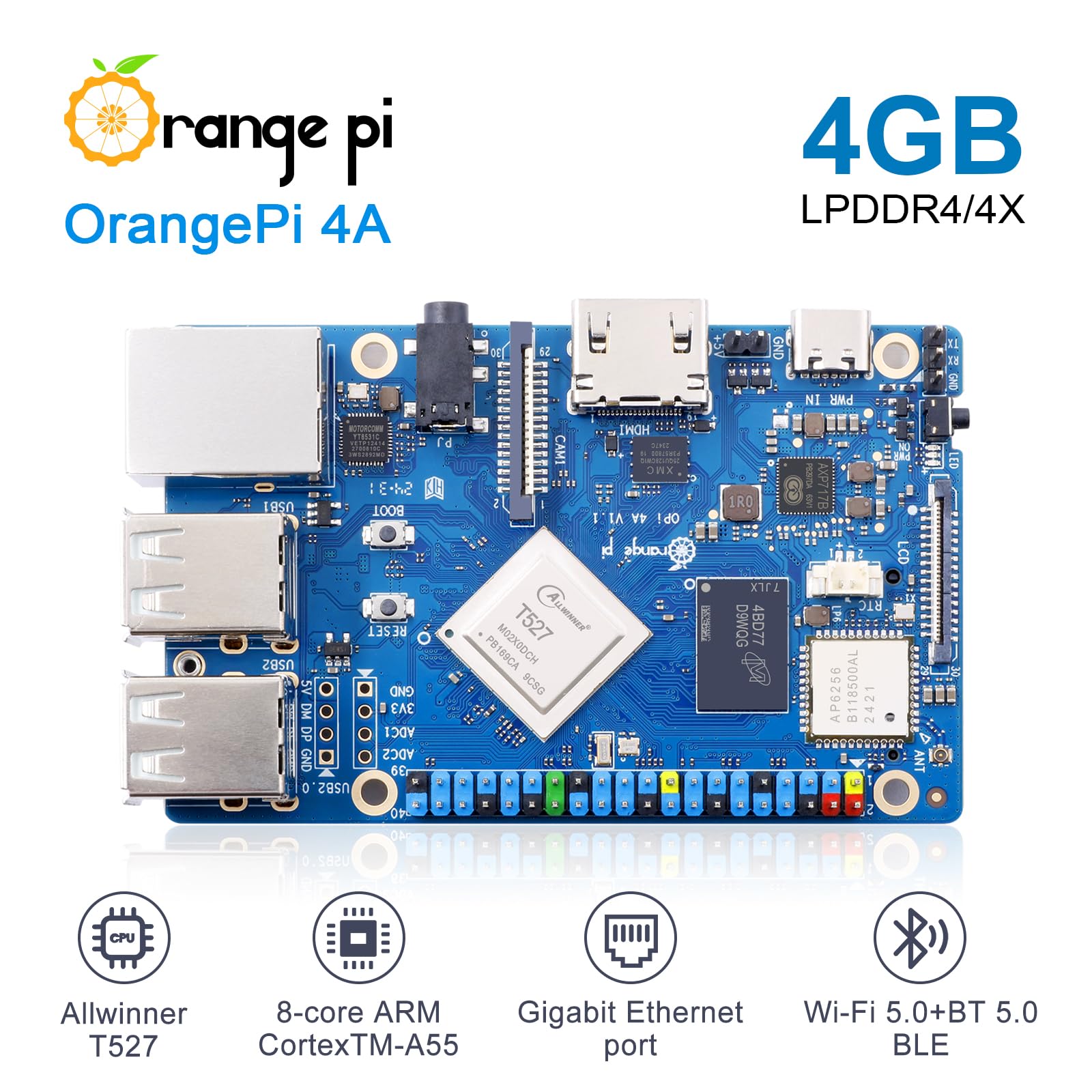









🚀 Unlock the future of edge computing with Orange Pi 4A — where power meets versatility!
The Orange Pi 4A is a compact single board computer powered by an Allwinner T527 octa-core Cortex-A55 processor with a RISC-V coprocessor and 2TOPS NPU for AI acceleration. It supports 2GB or 4GB LPDDR4X RAM, offers extensive connectivity including WiFi 5, Bluetooth 5.0, Gigabit Ethernet, PCIe 2.0, and multiple expansion ports. Compatible with Ubuntu, Debian, and Android 13, it’s designed for versatile development in AI, industrial control, and intelligent education.
| Processor | 1.8 GHz |
| RAM | LPDDR4X |
| Brand | Orange Pi |
| Series | Orange Pi 4A |
| Item model number | 4GB |
| Operating System | Debian, Linux, Android 12 |
| Item Weight | 3.2 ounces |
| Package Dimensions | 3.5 x 2.5 x 1.5 inches |
| Processor Brand | Allwinner |
| Number of Processors | 8 |
| Manufacturer | Orange Pi |
| ASIN | B0DN1GWVK6 |
| Country of Origin | China |
| Date First Available | November 14, 2024 |
J**B
Technical analysis of allwinner T527 vs BCM2711
The following is a datasheet analysis that shows the pros and cons of the op4a vs raspberry pi 4, which is in the same market segment.Summary: T527 found in op4a vs. Raspberry Pi 4**The **T527 processor** and **Raspberry Pi 4** cater to different use cases, with distinct advantages in specific areas:### **Performance & Architecture**- **T527**:- **Octa-core ARM Cortex-A55** (up to 1.8 GHz) + **RISC-V CPU** (200 MHz) for heterogeneous computing.- **2 TOPS NPU** for AI/ML tasks (absent in Pi 4).- **HiFi4 DSP** and **ARM G57 MC1 GPU** enhance multimedia and graphics performance.- **Raspberry Pi 4**:- Quad-core **Cortex-A72** (1.5 GHz) offers stronger single-threaded performance.- **VideoCore VI GPU** supports OpenGL ES 3.x and dual 4K displays.### **Memory & Storage**- **T527**: Supports up to **4GB LPDDR4X/DDR4** and multiple interfaces (eMMC5.1, NAND, SD 3.0).- **Pi 4**: Offers up to **8GB LPDDR4** but fewer storage interface options.### **Connectivity & I/O**- **T527**:- Dual **Gigabit Ethernet**, **PCIe 2.1**, **USB 3.1**, **4+4-lane MIPI CSI**, and multiple video outputs (HDMI 2.0, LVDS, eDP).- Extensive peripherals: **10 UARTs, 9 TWI, 30 PWM channels**, and **CAN bus** for industrial use.- **Pi 4**:- Single Gigabit Ethernet, dual micro-HDMI, USB 3.0, and a mature ecosystem for general-purpose projects.### **Multimedia & AI**- **T527**:- **4K@60fps H.265/VP9 decoding**, **4K@25fps H.264 encoding**, and ISP for camera processing.- **NPU** accelerates AI workloads (e.g., TensorFlow, PyTorch).- **Pi 4**: Lacks dedicated AI hardware but handles 4K video playback via software.### **Security & Industrial Features**- **T527**: Hardware encryption (AES, SM4), secure boot, and extended temperature support for automotive/industrial use.- **Pi 4**: Relies on software-based security and lacks ruggedized features.### **Power Efficiency**- **T527**: Cortex-A55 cores are more power-efficient, ideal for embedded/battery-powered systems.- **Pi 4**: Higher power draw under load due to older A72 architecture.### **Ecosystem & Use Cases**- **T527**: Targets **industrial, automotive, and AI applications** with specialized I/O and security.- **Pi 4**: Dominates in **hobbyist, education, and general computing** with vast community support and software compatibility.**Conclusion**:The T527 excels in **AI, industrial automation, and multimedia processing** with its NPU, security, and connectivity. The Raspberry Pi 4 remains superior for **general-purpose computing, affordability, and community-driven projects**. Choose the T527 for specialized, high-performance embedded systems; opt for the Pi 4 for flexibility and ease of use. In other words, the op4a is built significantly better designed for those who have more technical skills, while the raspi4 is catered to the hobbyist.
Trustpilot
3 days ago
2 weeks ago